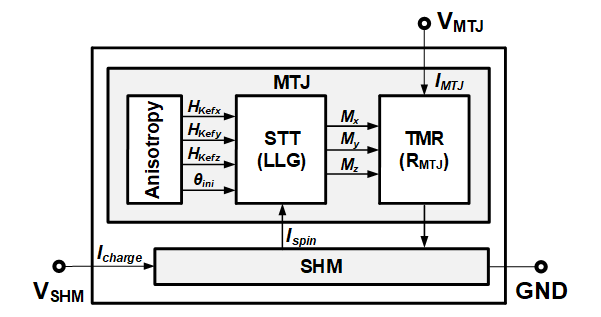Our spin hall effect (SHE) model uses similar approach as our STT model. The SHE model is also self-contained, physics based model for both MTJ and spin hall metal (SHM). The dimensions and magnetic parameters of both MTJ and SHM are inputs to this model. Additionally, this model includes the effect of initial angle and thermal fluctuation, both of them can be user-defined inputs. This model can be used for four modes of operation: STT only, SHE only with external field, SHE assisted STT, SHE assisted STT with external field.

Block diagram of physics-based SHE model
I. Ahmed, Z. Zhao, M. Mankalale, S. Sapatnekar, J.P. Wang, C.H. Kim, "A Comparative Study between Spin-Transfer-Torque (STT) and Spin-Hall-Effect (SHE) Switching Mechanisms using SPICE", IEEE Journal of Exploratory Solid-State Computational Devices and Circuits (JxCDC), Oct. 2017 [LINK TO PAPER]
Switching mechanism |
Device |
Parameter (Default) | Download |
||||||
|---|---|---|---|---|---|---|---|---|---|
| Dimension | Material | Ms0 | P0 | Alpha | RA | SHA | |||
| Spin hall effect (SHE) | Crystalline perpendicular MTJ | 45nm x 45nm x 0.7nm | FePdX | 1145 | 0.73 | 0.02 | 5 | - | SHE_model.zip |
| Spin hall metal | 60nm x 45nm x 5nm | beta-W | - | - | - | - | 0.4 | ||
By using our MTJ compact model, you agree to acknowledge the "UMN MTJ SPICE model, online: http://mtj.umn.edu" in your publications or presentations.
Step1. Download MTJ spice model.
Step2. Extract .zip file. STT model contains three separate zip files for in-plane, crystalline perpendicular and interface perpendicular MTJ.
Step3. Open MTJ_write.sp file (MTJ write example)
Step4. Set MTJ dimensions and material parameters: Ms0, P0, alpha, RA and initial temparature.
For SHE model, additional parameters, such as, SHM dimensions, and materials parameters.
You can also add the field-like torque as a fraction of damping like torque by changing the parameter x_ad .
Additionally, you can add thermal fluctuation (see Step7) in SHE and VCMA model.
(Ms0: saturation magnetization, P0: polarization, both at zero Kelvin temperature.)
Step5. Select anisotropy type using parameter 'MA':
ex) In-plane magnetic anisotropy: MA='0'
Perpendicular magnetic anisotropy: MA='1'
Step6. Select the initial state of free layer using parameter 'ini', and apply voltage with correct polarity.
Magnetization of the fixed layer will be set automatically according to the 'ini' value.
ex) Antiparallel to parallel switching : ini='1' with positive voltage
Parallel to antiparallel switching: ini='0' with negative voltage
Step7. Setting thermal fluctuation: A default thermal fluctuation SPICE file is already given.
Use the MATLAB code, "NoiseGen_MATLAB.m" to create thermal fluctuation SPICE file for a different parameter.
By setting the parameter x_thermal = 0, in the LLG_solver.inc file, the thermal fluctuation can be omitted.
Step8. Run SPICE simulation
This work was supported in part by C-SPIN, one of six centers of STARnet, a Semiconductor Research Corporation program, sponsored by MARCO and DARPA.